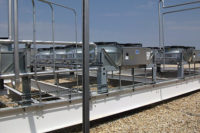In a communication with The NEWS dated Sept. 16, Midwest Refrigerants president Lewis Steinberg said, “The U.S. Patent Office advised us that the patent for our ODS/GHG conversion technology has been allowed. With the UNEP-TEAP approval of the technology to be confirmed at the Montreal Protocol meeting in November, we are now moving forward with the development of our U.S. facility.”
The Midwest conversion process was designed to deal with CFCs, HCFCs, and other refrigerants. Steinberg noted that while CFCs are not used very much and efforts are underway to phase out HCFCs, a great deal of equipment still uses HCFCs. And while recovery and reclaim is an ongoing factor, there is a point when these refrigerants have to be eliminated without venting, he said. To date, large rotary kilns or incinerators have been used for their destruction.
“Instead of destroying them, Midwest can take unwanted refrigerants and make them into something useful,” he said. In addition to CFCs and HCFCs, the approach can also deal with HFCs, HFOs, as well as perfluorocarbon compounds, halons, and certain bromides and chlorides, Steinberg said.
He said the Midwest approach involves a technology that doesn’t require a big industrial facility. The resulting byproducts can also be resold as raw materials to manufacture chemicals, aluminum, and electronics and for use in other industrial processes, he said.
The company’s website describes the CTC Refri-Green™ process as “a revolutionary new technology that safely, cleanly, inexpensively, and irreversibly eliminates ozone depleting substances (ODSs), greenhouse gases (GHGs), and many persistent organic pollutants (POPs) with virtually no atmospheric emissions.
“This is done by converting the ODSs, GHGs, and POPs back to their constituent/component chemicals.”
The website (www.midwestrefrigerants.com) also now documents the conversion flow process and neutralization flow processes used and shows conversion results.
POPs
Steinberg also drew attention to the fact “that the technology can be used to eliminate many types of POPs.”
In that regard, he cited a report from the Stockholm Convention of the United Nations Environment Programme (UNEP).
According to that report, “Persistent Organic Pollutants are organic chemical substances, that is, they are carbon-based. They possess a particular combination of physical and chemical properties such that, once released into the environment, they remain intact for exceptionally long periods of time (many years); become widely distributed throughout the environment as a result of natural processes involving soil, water and, most notably, air; accumulate in the fatty tissue of living organisms including humans, and are found at higher concentrations at higher levels in the food chain, and are toxic to both humans and wildlife.”
POPs have been used as pesticides and others are used in industrial applications and in the production of solvents, polyvinyl chloride, and pharmaceuticals.
Publication date: 11/07/2011









